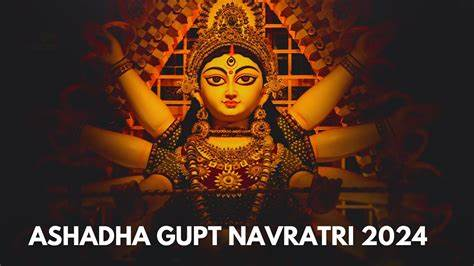Gupt Navratri
Gupt Navratri, also known as Gupta Navratri or Ashadha Navratri, is a lesser-known but significant Hindu festival dedicated to the worship of the nine forms of Goddess Durga. Unlike the more widely celebrated Sharad Navratri and Chaitra Navratri, Gupt Navratri is observed primarily by certain sects and individuals who seek spiritual elevation, mystical knowledge, and divine blessings.
Dates of Gupt Navratri 2024
In 2024, Gupt Navratri falls from July 6th to July 14th. The festival begins on the Pratipada (first day) of the Shukla Paksha (waxing phase of the moon) in the month of Ashadha, according to the Hindu lunar calendar.
Significance of Gupt Navratri
Spiritual Practice: Gupt Navratri is considered ideal for secretive and esoteric spiritual practices, including Tantra and Sadhana (spiritual discipline). Devotees engage in rituals that are often kept private, aimed at gaining spiritual power and knowledge.
Divine Feminine Power: The festival celebrates the divine feminine power and each of the nine days is dedicated to a different form of Goddess Durga. The forms include Shailaputri, Brahmacharini, Chandraghanta, Kushmanda, Skandamata, Katyayani, Kalaratri, Mahagauri, and Siddhidatri.
Purification and Renewal: Gupt Navratri is seen as a period of purification and renewal. Devotees undertake fasting, meditation, and prayers to cleanse their body and mind, seeking the blessings of the Goddess for prosperity and well-being.
Rituals and Practices
Kalash Sthapana (Ghatasthapana): The festival begins with the installation of a sacred pot (Kalash) symbolizing the universe. This ritual marks the start of Navratri and invokes the presence of Goddess Durga.
Fasting: Devotees observe fasts, which can vary from a strict water-only fast to more lenient ones where fruits, milk, and other sattvic (pure) foods are consumed. Fasting is believed to detoxify the body and mind, making one more receptive to spiritual practices.
Daily Puja: Each day of Gupt Navratri is marked by special prayers and offerings to the particular form of Goddess Durga being worshipped on that day. Mantras, devotional songs, and sacred texts like the Durga Saptashati are recited.
Tantric Rituals: For those practicing Tantra, Gupt Navratri holds special importance. Secretive rituals, mantras, and meditations are performed to seek siddhis (spiritual powers) and divine guidance. These practices are typically done under the guidance of a knowledgeable guru.
Kanya Puja: On the eighth or ninth day of Navratri, young girls (representing the nine forms of Goddess Durga) are worshipped and offered food, gifts, and new clothes. This ritual is known as Kanya Puja and symbolizes the worship of the divine feminine.
Homa and Yajna: Sacred fire rituals, known as Homa or Yajna, are conducted to honor the Goddess and seek her blessings. Offerings are made into the fire while chanting specific mantras.
Conclusion
Gupt Navratri is a deeply spiritual and mystical festival that provides devotees with an opportunity to engage in profound worship and spiritual practices. Though not as widely recognized as Sharad or Chaitra Navratri, it holds immense significance for those seeking inner transformation and divine blessings. The rituals and observances of Gupt Navratri help in purifying the mind and body, allowing devotees to connect with the divine feminine energy and attain spiritual growth.

Comments
Post a Comment